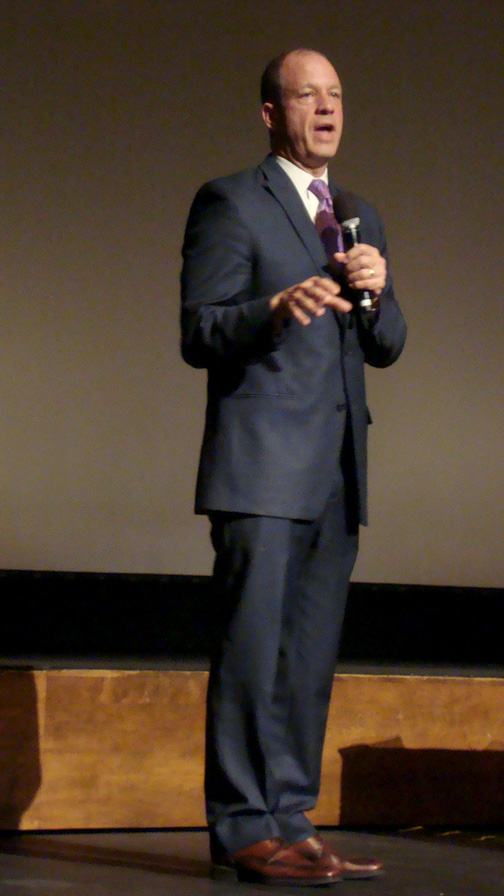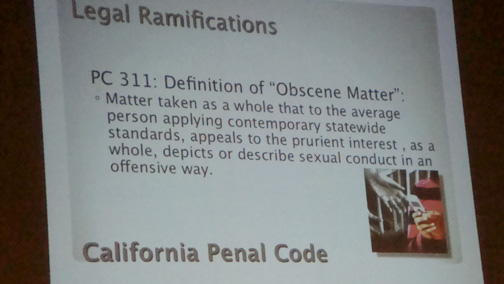
Detective Donald Tucker of the GPD Violent Crimes Bureau defines sexting and its consequences.
By Jason KUROSU
Though they are increasingly adept at utilizing social media resources, some teenagers’ social media habits are hurting their future career opportunities or even implicating them in crimes, according to school district and police officials. A GUSD hosted parent forum on internet safety examined the latest issues regarding social media use, including a growing trend of teens sharing sensitive information online.
Detective Donald Tucker of the Glendale Police Department, Violent Crimes Bureau, spoke on the rising prevalence of sexting, or sending nude photos, something which could be legally construed as the creation, possession and distribution of child pornography.
Even when sexting occurs between two minors, California law considers the act equivalent to creating and sharing child pornography, a felony which in addition to jail time, could force the involved minors to register as sex offenders.
Though the pictures are often shared with the understanding of privacy and discretion, Tucker said that when those pictures fall into the wrong hands, they can be used to threaten the subject of the pictures in terms of blackmail.
“Recent trends with sexting is the use of explicit pictures against the teen who sent them. Sometimes they can be pressured into sending more graphic pictures,” said Tucker. “Just remember, you may think you can trust the person that you’re sexting, but once those pictures are out, they’re always out.”
Tucker suggested parents speak to their children about sexting and its risks, saying that talking with your children will not increase sexting activity, but rather dispel the mystery.
Additional social media concerns include cyber bullying and other public threats against students, teachers or themselves, which have led GUSD to begin monitoring computer activity at their campuses.
The Glendale Unified School District began working with Geo Listening in 2013, allowing the company to monitor any public social media posts made on school campus computers and report suspicious posts to the school district. GUSD entered into an agreement with Geo Listening, emphasizing that student safety was the primary focus of using the service.
Dr. Scott Anderle of GUSD Student Support Services reviews Geo Listening’s daily reports on all secondary schools (junior high and high school) within the district. Anything posted publicly is detected by the monitoring service and the district is sent daily reports on activity which triggers their list of around 50 keywords on a range of topics. A typical day’s report could include anything from rumors to outright evidence of bullying, cheating on tests, illicit drug activity, violent threats or suicidal thoughts.
Anderle said he mainly looks for “students who are threatening to hurt themselves or hurt others” as well as what topics are popular and potentially dangerous amongst the student body, such as e-cigarettes and street racing.
At the event, Anderle said that teenagers often harbor misconceptions about the public nature of their social media posts.
“I always hear two things. Number one, ‘What I post and send privately, stays private.’ Number two, ‘This stuff won’t hurt me in the long run.’ Those things are not true. Private stuff does not stay private.”
Anderle also said that public posts can reflect upon a student well past their school years, as conversations with college and job recruiters have indicated that universities and employers search online through social media sites when evaluating prospective students or hires.
“Companies don’t want to have sexual harassment or discrimination lawsuits,” said Anderle. “If they think that you’re going to be someone who’s going to harass other people and not get along with other people, they’re not going to hire you.”
Anderle said that consequences, as long as they will not involve the police, are left to the discretion of the respective school sites, but police involvement is not out of the question when danger to oneself or others is suggested, even if the intent was not serious.
“Jokes are no joke,” said Anderle. “I’ve got a student who posted one of those jokes who’s wearing an ankle bracelet. He’s being monitored by the police as a possible threat to society because of what he posted on the internet, which was supposedly a joke.”
Tina Givrad, who has a biomedical engineering doctorate and teaches at Cal State Los Angeles, delved into the decision making process of teenagers from a biological perspective, noting the fluid development of the teenage brain.

Givrad said that much of the brain’s development occurs between puberty and adulthood. One part of the brain which is not fully developed during adolescence, yet is crucial to decision making is the frontal lobe. However, the amygdala, which controls instinctive “fight or flight” type responses, is extremely active during the teenage years.
“The amygdala gets active when there is a change in our environment. By definition, teenage years are the years that the body goes through both emotional and physical changes, so the amygdala is superactive here.”
Givrad recommended understanding and guidance for teens trying to manage busy school lives with rapid changes in brain chemistry.
“Just because they are taller than us, just because they can drive, just because they ‘don’t need us anymore,’ it does not mean that they really do not need us. Your teenagers need you more than ever in their lives.”
